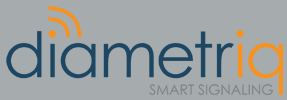Web-based Traffic Model Calculates LTE Diameter Signaling Load
Melbourne, FL – September 17, 2012 – Diametriq, a leader in addressing LTE signaling network issues, announced today the first web-based interactive tool that automatically calculates the Diameter signaling load based on a variety of input variables such as the number of LTE devices and how subscribers use them. The Diameter Traffic Calculator™ generates reports that include graphical presentations and signaling load by network element.
“The industry has been projecting signaling overload in LTE networks, the so called signaling tsunami or signaling storm,” said Anjan Ghosal, president and CEO of Diametriq. “Diametriq’s LTE Signaling Traffic Calculator provides accurate projections of signaling hot spots so they can be addressed before the congestion causes service outages.”
The Diameter Traffic Calculator uses eight variables such as the number of LTE devices, and their projected yearly growth, number of simultaneous applications and expected dormancy of applications to estimate the diameter traffic in a specific network. It also factors in the percentage of postpaid subscribers and projected VoLTE users. The results are extrapolated over a 5 years period based on specified growth rates. In addition to reporting total Diameter messages per year, the tool also projects Diameter messages by network element: HSS, PCRF and OCS. Graphical representations of the results are also provided and the results can be exported to a spreadsheet. The Calculator can be accessed from Diametriq’s website at http://diametriq.com/lte-diameter-traffic-calculator/.
“Operators are a bit skeptical of market reports that have given a very wide range of traffic projections” commented Mr. Ghosal. “This tool is the first attempt in the industry to allow operators to input their own network information and get a customized Diameter traffic profile for their own network.”
The Diameter Traffic Calculator can be used by network operators to understand if and when there will be congestion in the control plane. 4G networks generate more signaling traffic, especially with the growth of 4G devices and the explosion of applications that run on them. The industry has defined the Diameter Signaling Controller (DSC), which addresses signaling issues in LTE networks such as traffic management, service enablement and interoperability. The Traffic Calculator can be used by network operators to predict when a DSC will be needed, where it should be placed in the network and how to scale for future growth.
“While 4G opportunities are alluring, they are accompanied by non-trivial challenges including exponential growth in signaling traffic driven by data-rich applications from always-on smart phones. Unless appropriately addressed, excessive signaling can be detrimental to the data core potentially bringing down vital network elements” said Sridhar Pai, CEO of Tonse Telecom, a research firm tracking the wireless industry. “The Diametriq tool is interactive and is useful in generating a series of ‘what-if’ scenarios to envisage signaling overload for a mix of device and application use cases”.
“While the interactive tool is simple to use, the model behind it is actually quite complex,” added Mr. Ghosal. “Interested parties can request a customized signaling traffic model with additional parameters and a higher degree of precision by contacting Diametriq.”
Diametriq, an innovator in LTE signaling control technologies, was launched in 2012 to focus on “Smart Signaling” solutions and meeting the ever increasing signaling traffic demands of 4G/LTE networks. The company was derived from key assets including executive leadership, engineering, and technologies from IntelliNet Technologies, a wireless solutions company founded in 1992. Diametriq boasts a high performance Diameter platform that is widely deployed by leading network operators around the globe.
Diametriq’s flagship product is its Diameter Routing Engine™ (DRE) which provides load balancing, roaming and interworking that can be customized to an operator’s specific requirements. The platform is flexible to meet the demands of today’s wireless operators that must manage the surge in signaling traffic brought about by the dramatic growth in smart phone, tablet and other wireless devices.




